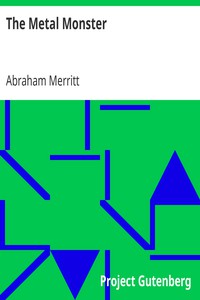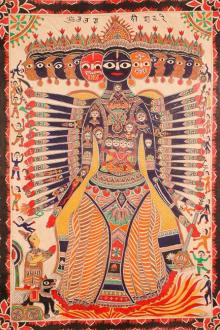The Metal Monster, Abraham Merritt [have you read this book TXT] 📗

- Author: Abraham Merritt
Book online «The Metal Monster, Abraham Merritt [have you read this book TXT] 📗». Author Abraham Merritt
“Wait,” he said. “I carried away some—some exhibits from the crevice of the noises, Goodwin.”
“What kind of exhibits?” I asked, eagerly.
“Put 'em where they'd be safe,” he continued. “I've an idea they're far more curious than our armored men—and of far more importance. At any rate, we must take them with us.
“Go with Ruth, you and Drake, and look at them. And bring them back with the pony. Then we'll make a start. A few minutes more probably won't make much difference—but hurry.”
He turned back to his watch. Ordering Chiu-Ming to stay with him I followed Ruth and Drake down the ruined stairway. At the bottom she came to me, laid little hands on my shoulders.
“Walter,” she breathed, “I'm frightened. I'm so frightened I'm afraid to tell even Mart. He doesn't like them, either, these little things you're going to see. He likes them so little that he's afraid to let me know how little he does like them.”
“But what are they? What's to fear about them?” asked Drake.
“See what you think!” She led us slowly, almost reluctantly toward the rear of the fortress. “They lay in a little heap at the mouth of the cleft where we heard the noises. Martin picked them up and dropped them in a sack before we ran through the hollow.
“They're grotesque and they're almost CUTE, and they make me feel as though they were the tiniest tippy-tip of the claw of some incredibly large cat just stealing around the corner, a terrible cat, a cat as big as a mountain,” she ended breathlessly.
We climbed through the crumbling masonry into a central, open court. Here a clear spring bubbled up in a ruined and choked stone basin; close to the ancient well was their pony, contentedly browsing in the thick grass that grew around it. From one of its hampers Ruth took a large cloth bag.
“To carry them,” she said, and trembled.
We passed through what had once been a great door into another chamber larger than that we had just left; and it was in better preservation, the ceiling unbroken, the light dim after the blazing sun of the court. Near its center she halted us.
Before me ran a two-feet-wide ragged crack, splitting the floor and dropping down into black depths. Beyond was an expanse of smooth flagging, almost clear of debris.
Drake gave a low whistle. I followed his pointing finger. In the wall at the end whirled two enormous dragon shapes, cut in low relief. Their gigantic wings, their monstrous coils, covered the nearly unbroken surface, and these CHIMERAE were the shapes upon the upthrust blocks of the haunted roadway.
In Ruth's gaze I read a nameless fear, a half shuddering fascination.
But she was not looking at the cavern dragons.
Her gaze was fixed upon what at my first glance seemed to be a raised and patterned circle in the dust-covered floor. Not more than a foot in width, it shone wanly with a pale, metallic bluish luster, as though, I thought, it had been recently polished. Compared with the wall's tremendous winged figures this floor design was trivial, ludicrously insignificant. What could there be about it to stamp that dread upon Ruth's face?
I leaped the crevice; Dick joined me. Now I could see that the ring was not continuous. Its broken circle was made of sharply edged cubes about an inch in height, separated from each other with mathematical exactness by another inch of space. I counted them—there were nineteen.
Almost touching them with their bases were an equal number of pyramids, of tetrahedrons, as sharply angled and of similar length. They lay on their sides with tips pointing starlike to six spheres clustered like a conventionalized five petaled primrose in the exact center. Five of these spheres—the petals—were, I roughly calculated, about an inch and a half in diameter, the ball they enclosed larger by almost an inch.
So orderly was their arrangement, so much like a geometrical design nicely done by some clever child that I hesitated to disturb it. I bent, and stiffened, the first touch of dread upon me.
For within the ring, close to the clustering globes, was a miniature replica of the giant track in the poppied valley!
It stood out from the dust with the same hint of crushing force, the same die cut sharpness, the same METALLIC suggestion—and pointing toward the globes were the claw marks of the four spreading star points.
I reached down and picked up one of the pyramids. It seemed to cling to the rock; it was with effort that I wrenched it away. It gave to the touch a slight sensation of warmth—how can I describe it?—a warmth that was living.
I weighed it in my hand. It was oddly heavy, twice the weight, I should say, of platinum. I drew out a glass and examined it. Decidedly the pyramid was metallic, but of finest, almost silken texture—and I could not place it among any of the known metals. It certainly was none I had ever seen; yet it was as certainly metal. It was striated—slender filaments radiating from tiny, dully lustrous points within the polished surface.
And suddenly I had the weird feeling that each of these points was an eye, peering up at me, scrutinizing me. There came a startled cry from Dick.
“Look at the ring!”
The ring was in motion!
Faster the cubes moved; faster the circle revolved; the pyramids raised themselves, stood bolt upright on their square bases; the six rolling spheres touched them, joined the spinning, and with sleight-of-hand suddenness the ring drew together; its units coalesced, cubes and pyramids and globes threading with a curious suggestion of ferment.
With the same startling abruptness there stood erect, where but a moment before they had seethed, a little figure, grotesque; a weirdly humorous, a vaguely terrifying foot-high shape, squared and angled and pointed and ANIMATE—as though a child should build from nursery blocks a fantastic shape which abruptly is filled with throbbing life.
A troll from the kindergarten! A kobold of the toys!
Only for a second it stood, then began swiftly to change, melting with quicksilver quickness from one outline into another as square and triangle and spheres changed places. Their shiftings were like the transformations one sees within a kaleidoscope. And in each vanishing form was the suggestion of unfamiliar harmonies, of a subtle, a transcendental geometric art as though each swift shaping were a symbol, a WORD—
Euclid's problems given volition!
Geometry endowed with consciousness!
It ceased. Then the cubes drew one upon the other until they formed a pedestal nine inches high; up this pillar rolled the larger globe, balanced itself upon the top; the five spheres followed it, clustered like a ring just below it. The other cubes raced up, clicked two by two on the outer arc of each of the five balls; at the ends of these twin blocks





Comments (0)